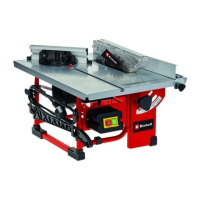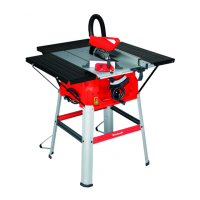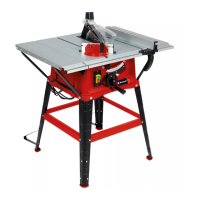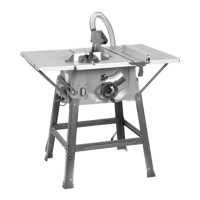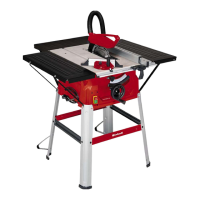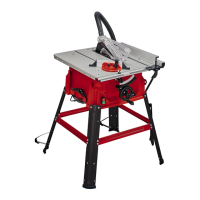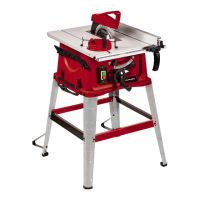GB
- 26 -
7. Operation
7.1 On/Off switch (Fig. 1, 15 / Item 11)
•
To turn the saw on, press the green button
„I“. Wait for the blade to reach its maximum
speed of rotation before commencing with the
cut.
•
To turn the equipment off again, press the red
button „0“.
The motor of this equipment is protected against
overload by an overload switch (10). If the rated
current is exceeded, the overload switch (10) will
shut down the equipment.
•
Let the equipment cool down for several mi-
nutes.
•
Press the overload switch (10).
•
Press the green button „I“ to switch on the
equipment.
7.2 Cutting depth (Fig. 1, 15)
Turn the hand wheel (8) to set the blade (4) to the
required cutting depth.
Turn anti-clockwise:
smaller cutting depth
Turn clockwise:
larger cutting depth
7.3 Parallel stop
The parallel stop (7) has to be used when making
longitudinal cuts in wooden workpieces.
7.3.1 Stop height (Fig. 1b, 11, 12)
•
Fit the parallel stop to the saw table by screw-
ing the holder (24) to the table: On the outside
of the table: locking screw (12) and washer
(34). On the inside of the table: clamping
plate (33). Then use the screws (13) and the
knurled screws (26) to screw the stop rail (23)
and the holder (24) together.
•
The parallel stop (7) supplied with the bench-
type circular saw has two different guide
faces.
•
For thick material you must use the stop rail
(23) as shown in Fig. 11, for thin material you
must use the stop rail as shown in Fig. 12.
•
To change over the stop rail (23) to the lo-
wer guide face you have to slacken the two
knurled screws (26).
•
Remove the two screws (13) from the parallel
stop through the one slot (27) in the stop rail
(23).
•
Thread the two screws (13) into the other slot
(25) in the stop rail (23) and slide the stop rail
(23) back onto the parallel stop.
•
Retighten the two knurled screws (26) in or-
der to fix the stop rail (23).
•
The procedure for changing over to the high
guide face is the same.
•
Warning! When in use, the stop rail (23) must
always be screwed to the side of the parallel
stop (7) which faces the saw blade.
7.3.2 Cutting width (Fig. 11, 12)
•
The parallel stop (7) can be mounted on eit-
her side of the saw table (1).
•
The parallel stop (7) can be set to the requi-
red dimension with the help of the scale (22)
engraved on the saw table (1).
•
Tighten the two locking screws (12) in order
to fix the parallel stop (7).
•
Make a trial cut in order to measure the width
before you cut the actual workpiece itself. This
will help you avoid any inaccuracies in the
scale or setting.
7.3.3 Setting the stop length (Fig. 13)
•
The stop rail (23) can be moved in longitudi-
nal direction in order to prevent the workpiece
from becoming jammed.
•
Rule of thumb: The rear end of the stop co-
mes up against an imaginary line that begins
roughly at the center of the blade and runs at
an angle of 45° to the rear.
•
Set the required cutting width
- Slacken the knurled screws (26) and push
the stop rail (23) forward until it touches the
imaginary 45° line.
- Retighten the knurled screws (26).
7.4 Cross stop (Fig. 14)
The cross stop (14) has to be used when making
cross cuts in wooden workpieces.
•
Undo the two knurled screws (26) and pull the
stop rail (23) off the holder (24).
•
Fasten the stop rail (23) using the screws (40)
and the knurled screws (41) on the cross stop
(14).
•
Slide the cross stop (14) into the slot (21) of
the saw table.
•
Undo the locking screw (28).
•
Turn the stop rail (23) until the arrow points to
the angle required.
•
Re-tighten the fastening screw (28).
•
Check the gap between the stop rail (23) and
the saw blade (4).
•
Warning! Do not push the stop rail (23) too
Anl_TC_TS_210_SPK9.indb 26Anl_TC_TS_210_SPK9.indb 26 07.11.2019 08:49:3107.11.2019 08:49:31
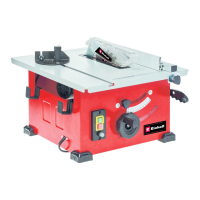
